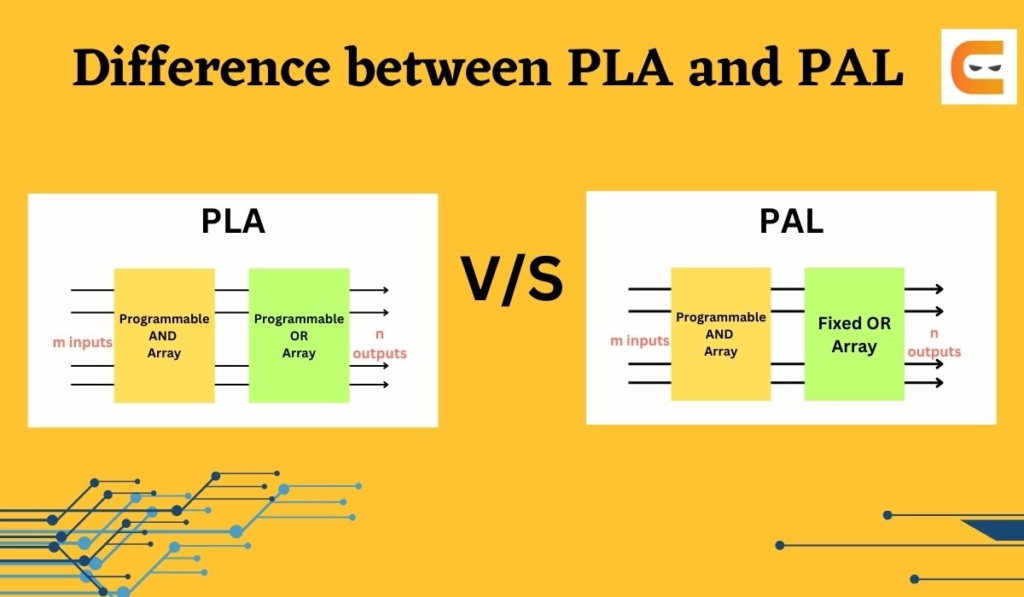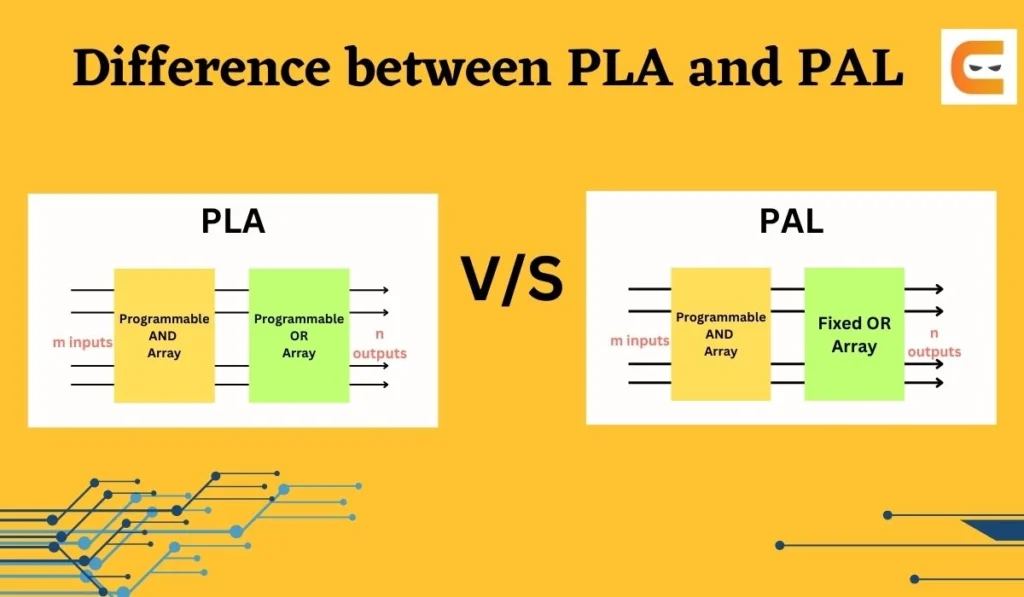Digital circuit design’s core components that offer adaptability and reconfigurability are programmable array logic (PAL) and programmable logic array (PLA). Engineers can effectively build and optimize digital systems thanks to these devices’ vital role in implementing complex logic operations.
We will look at the distinctions between PAL and PLA, as well as their functional principles, benefits, and common applications, in this post. We will contrast PAL and PLA as well, demonstrating how they differ in terms of their structural makeup, logical prowess, level of design complexity, and performance requirements. Designers will be better equipped to choose the best device for their particular application if they are aware of these distinctions.
In order to fully grasp the benefits and advantages of PAL and PLA in these situations, we will also examine how they are applied to various types of logic circuits, including combinational and sequential circuits. We will also talk about PAL and PLA technology developments and how they affect circuit design and application.
You will have a thorough understanding of PAL and PLA by the end of this article, enabling you to choose how to use them in digital circuit design. So let’s start by going over the fundamentals of PAL and PLA and their importance in contemporary electronics.

Understanding PAL
A. Definition and Architecture of PAL
Definition: PAL (Programmable Array Logic) is a type of programmable logic device that consists of an array of programmable AND gates followed by a fixed OR gate.
Architecture: PAL is composed of three main components: an input matrix, an output matrix, and a programmable OR array.
- Input Matrix: The input matrix consists of programmable AND gates that allow for the combination of input signals. These gates are programmable, meaning their connections can be configured to create different logic functions.
- Output Matrix: The output matrix consists of a fixed OR gate that combines the outputs from the programmable AND gates in the input matrix. The output matrix provides the final logic function of the PAL.
- Programmable OR Array: The programmable OR array allows for the connection of various inputs to different OR gates in the output matrix. This enables the implementation of complex logic functions.
B. Working Principle and Components of a PAL
Working Principle: The input and output matrices are programmed using a particular hardware programming language or software tools when designing with a PAL. The programming sets up the AND gates and OR gates’ connections to carry out the specified logic function.
Components of PAL
- Programmable AND Gates: The programmable AND gates in the input matrix can be programmed to connect specific inputs to generate the desired logical expressions.
- Fixed OR Gate: The fixed OR gate in the output matrix combines the outputs from the programmable AND gates to produce the final output signal.
- Programming Interface: PAL devices are typically programmed using specialized hardware programmers or software tools that provide the necessary interface to configure the interconnections of the gates.
C. Advantages and Disadvantages of PAL
Advantages:
- Flexibility: PAL devices offer a high degree of flexibility since the interconnections of the AND gates can be easily programmed to implement various logic functions.
- Cost-Effectiveness: PALs are generally more cost-effective compared to other programmable logic devices due to their simpler architecture.
- Compact Size: PALs are available in small form factors, making them suitable for applications with limited space requirements.
Disadvantages:
- Limited Complexity: PALs have limitations in implementing complex logic functions compared to other programmable logic devices like CPLDs (Complex Programmable Logic Devices) or FPGAs (Field-Programmable Gate Arrays).
- Fixed OR Gate: The fixed OR gate restricts the PAL’s ability to perform more advanced logic functions that require complex combinations of signals.
D. Typical Applications of PAL
PALs are commonly used in various digital circuit applications, including:
- Data Encoding and Decoding: PALs can be used to encode or decode data signals in applications such as communication systems.
- Code Conversion: PALs can be utilized to convert between different coding schemes, such as binary to Gray code conversion.
- Address Decoding: PALs are often employed in memory systems to decode addresses and enable the selection of specific memory locations.
- Arithmetic Logic Units (ALUs): PALs can be used to implement ALUs in processors, performing arithmetic and logic operations.
Understanding PLA
A. Definition and architecture of PLA:
Definition: A programmable AND array and a programmable OR array make up a digital circuit known as a programmable logic array (PLA), which enables variable logic implementation.
Architecture: A PLA typically comprises two main components:
- Programmable AND array: This section consists of a matrix of programmable AND gates, where inputs can be combined using various logic functions such as AND, OR, NAND, NOR, etc. The outputs of these gates are fed into the OR array.
- Programmable OR array: The outputs from the AND array are connected to a programmable OR array, which combines the signals using OR logic operations to produce the final output.
B. Working principle and components of a PLA:
Working principle: The AND and OR arrays are programmed in a PLA in order to implement particular logic operations. The circuit’s inputs are connected to the inputs of the AND array, and the array’s outputs are connected to the inputs of the OR array. The needed logic functions can be created by programming the relevant connections and values in the AND and OR arrays.
Components of a PLA:
- Input lines: These are the input signals to the PLA, which can be either high (1) or low (0) logic levels.
- Programmable AND array: The matrix of programmable AND gates, which allows for combining inputs using various logic functions.
- Programmable OR array: The array of programmable OR gates, combines the outputs from the AND array to generate the final output.
- Output lines: These are the output signals produced by the PLA, representing the desired logic function.
C. Advantages and disadvantages of PLA:
Advantages:
- Flexibility: PLA offers high flexibility in implementing complex logic functions due to its programmable nature.
- Compactness: PLA designs can be more compact than alternative implementations for certain logic functions, reducing circuit complexity and size.
- Reduced power consumption: Compared to other programmable logic devices, PLA can consume less power, especially when optimized for specific applications.
Disadvantages:
- Limited scalability: PLA designs can become cumbersome and complex for larger logic functions, limiting their scalability.
- Longer propagation delays: PLA may have longer propagation delays due to the cascading of multiple AND and OR gates, which can affect the overall circuit speed.
- Higher design effort: Designing a PLA circuit requires careful consideration of the input equations and programming the AND and OR arrays, which can be time-consuming.
D. Typical applications of PLA:
- Control unit design in microprocessors: PLA is commonly used to implement the control logic in microprocessors, enabling efficient instruction decoding and sequencing.
- Digital signal processing: PLA can be employed in applications such as image processing, audio processing, and communication systems to implement various signal processing algorithms.
- Data compression and encryption: PLA circuits are utilized in data compression algorithms, encryption schemes, and error detection/correction techniques.
- Complex combinatorial logic: PLA finds applications in designs requiring complex combinatorial logic functions, such as pattern matching, code conversion, and protocol handling.
Comparison between PAL and PLA
A. Structural differences between PAL and PLA:
PAL (Programmable Array Logic):
- PAL consists of an array of AND gates followed by a fixed OR gate.
- The output of each AND gate is connected to the input of the OR gate.
- The connections between inputs and AND gates are programmable using a fuse or anti-fuse technology.
PLA (Programmable Logic Array):
- PLA consists of an array of programmable AND gates followed by programmable OR gates.
- The inputs of the AND gates and the outputs of the OR gates are programmable through a matrix of fuses or anti-fuses.
- The number of inputs and outputs in a PLA can vary based on the specific design.
B. Logic capabilities and flexibility of PAL vs. PLA:
PAL:
- PAL provides a limited number of inputs and outputs, which restricts the complexity of the logic functions it can implement.
- Due to the fixed OR gate structure, PALs are generally suited for simpler logic functions.
- PALs offer high flexibility in terms of reprogramming the connections between inputs and AND gates.
PLA:
- PLA offers greater flexibility and higher logic capacity compared to PAL.
- With the ability to program both the AND gates and OR gates, PLA can implement more complex logic functions.
- PLA allows for a wider range of input and output configurations, making it suitable for a broader range of applications.
C. Design complexity and cost considerations:
PAL:
- PALs have simpler architecture, resulting in lower design complexity.
- The reduced complexity often leads to lower manufacturing costs for PAL devices.
- However, PALs may require additional external logic components to implement more complex functions, which can increase overall system cost.
PLA:
- PLA’s flexibility and larger logic capacity make it capable of implementing complex functions without the need for additional external components.
- The increased logic capacity and flexibility can result in higher design complexity and manufacturing costs compared to PALs.
D. Performance and speed comparisons:
PAL:
- PALs typically have faster propagation delays and shorter routing paths due to their simpler structure.
- The reduced complexity allows for faster signal routing and quicker response times in PAL-based circuits.
PLA:
- PLA’s more complex structure and larger logic capacity may introduce longer propagation delays and increased signal routing complexity.
- However, advancements in technology have minimized the performance differences between PAL and PLA in modern designs.
E. Design trade-offs: When to choose PAL or PLA:
- PALs are generally preferred when the logic functions are relatively simple, and flexibility in reprogramming is required.
- PLA is a better choice for applications that demand more complex logic functions, higher logic capacity, and a wider range of input/output configurations.
- Cost considerations, performance requirements, and design complexity also play a significant role in selecting between PAL and PLA architectures.
By understanding the structural differences, logic capabilities, design complexity, performance factors, and design trade-offs between PAL and PLA, designers can make informed decisions regarding their choice of programmable logic devices for different applications.
PAL vs. PLA in Specific Applications
A. PAL and PLA in Combinational Logic Circuits
Use cases and advantages of PAL:
- PALs are commonly used in applications where the logic functions are fixed and well-defined, such as in address decoding circuits and data multiplexers.
- PALs offer a higher density of gates, allowing for more complex logic functions to be implemented in a smaller physical space.
Example: In a microprocessor, a PAL can be used for decoding the address bus to select specific memory locations or peripheral devices. This enhances the overall performance and functionality of the microprocessor.
Use cases and advantages of PLA:
- PLAs are suitable for applications that require flexible logic functions and can benefit from on-the-fly reprogramming capabilities.
- PLAs excel in applications where frequent changes in logic functions are expected or where customized logic functions need to be implemented.
Example: In a complex control system, a PLA can be used to implement a state machine that controls the sequencing and timing of various operations. The ability to reprogram the PLA allows for modifications and updates to the control logic without the need for hardware changes.
B. PAL and PLA in Sequential Logic Circuits
Use cases and advantages of PAL:
- PALs can be used in sequential circuits where the feedback path is limited and the number of flip-flops required is relatively small.
- PALs offer a faster propagation delay compared to PLAs, making them suitable for applications with tight timing requirements.
Example: In a counter circuit, a PAL can be used to implement the next state logic that determines the sequence of the counter. This enables efficient counting and control operations.
Use cases and advantages of PLA:
- PLAs are well-suited for sequential circuits with complex feedback paths and a large number of flip-flops.
- PLAs provide greater flexibility in designing sequential circuits with multiple state transitions and complex control logic.
Example: In a digital communication system, a PLA can be used to implement the encoding and decoding algorithms for error correction, allowing for efficient data transmission and reliable communication.
C. PAL and PLA in Complex Digital Systems
Use cases and advantages of PAL:
- PALs are commonly used in embedded systems where space is a critical factor and the logic functions are fixed and well-defined.
- PALs offer a cost-effective solution for implementing standard and repetitive logic functions in large-scale integrated circuits.
Example: In a digital signal processor (DSP), a PAL can be used for implementing arithmetic and logic functions, enabling efficient data processing and manipulation.
Use cases and advantages of PLA:
- PLAs find applications in complex digital systems where the logic functions are subject to changes and customization.
- PLAs provide the flexibility to adapt and modify the logic functions without the need for significant hardware changes.
Example: In a reconfigurable computing system, a PLA can be used for implementing custom logic functions based on the specific computational requirements of different applications, allowing for improved performance and versatility.
By utilizing PALs and PLAs effectively in specific applications, designers can optimize the performance, flexibility, and cost-efficiency of their digital circuits.
Conclusion
Key elements in the design of digital circuits are PAL (Programmable Array Logic) and PLA (Programmable Logic Array). PLAs provide more versatility and support for complicated logic functions, but PALs offer simplicity, small size, and faster performance.
Design complexity, performance requirements, cost, and required flexibility are a few of the aspects that designers must take into account while deciding between PAL and PLA. PALs work well for more compact and straightforward designs, whereas PLAs flourish in systems and projects that are bigger in scope and have more complex logic requirements.
Digital circuit design is constantly evolving, with improvements in performance, density, and programmability being driven by PAL and PLA technology advancements.
In conclusion, PALs and PLAs are essential for implementing logic operations, and knowing how they differ from one another enables designers to make wise choices. The creation of sophisticated electronic systems is made possible by these programmable logic circuits.


![What is FPGA Introduction to FPGA Basics [2023] computer-chip-dark-background-with-word-intel-it](https://fpgainsights.com/wp-content/uploads/2023/06/computer-chip-dark-background-with-word-intel-it-300x171.jpg)









